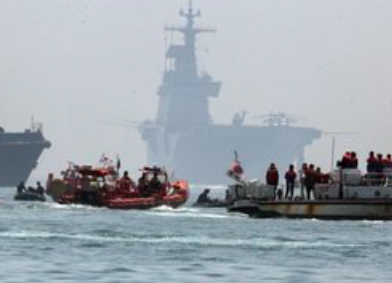 Click here to view article as a PDF.
Click here to view article as a PDF.
Soon after the tragic sinking of the MV Sewol, a South Korean ferry en route from Incheon to the island of Jeju on April 16th, 2014, Sound Metrics Corp took an active involvement in providing assistance to South Korea’s recovery efforts.
The Japanese-made MV Sewol was carrying 476 passengers, most of them high-school students, when it capsized in what should have been a routine trip from the city to a holiday island. As a result of a delay in initial rescue response, 288 people died, 172 were rescued, while 16 others are yet missing.
Jeanne Dorsey, Sales Manager for Sound Metrics Corp, was contacted on May 2, 2014 by Anna Jo, an International Cooperation Representative from the South Korean Ministry of Oceans and Fisheries to inquire about using the DIDSON Diver-Held sonar in the recovery effort for victims of the ferry accident. Jeanne promptly responded to Anna with training materials and additional details, ensuring her that Sound Metrics sonars are US Military approved for search and rescue work and that we would happily be of assistance.
Due to the urgency of the situation, Jeanne was asked to open her office on Saturday, May 3 for two representatives of the Republic of Korea to inform them of how the Diver-Held system works and show them actual sonar data in person. Soon after, we were tasked by the Republic of Korea to provide two DIDSON DH (Diver-held) sonars and on-site technical assistance as soon as possible.
As this critical order was made on short notice over the weekend, the Sound Metrics staff volunteered their time and worked tirelessly to prepare units to be ready for shipment Monday morning. “The Sound Metrics team went above and beyond,” Richard Morris, Sound Metrics’ General Office Manager commented, “No one asked for overtime, they all just told us, ‘If you need me, I’ll be there.’”
Thanks to the hard work of the Sound Metrics team, Joe Burch, President, and Bill Hanot, Vice-President, left Seattle Monday morning in order to arrive in Icheon, South Korea on Tuesday May 6. After landing in South Korea, Joe and Bill were met by Daniel, Felix, and Jason from Sound Metrics’ local sales contractor, OceanTech, to expedite the transportation of equipment from the airport to the marine university in Mopko, where diver training was to take place. Joe, Bill, and sonars all arrived in Mopko in top condition on Wednesday, May 7. From order to arrival, we were able to come to the assistance of South Korea’s search and recovery efforts in only four days!
Joe and Bill immediately began training divers in a series of classroom sessions followed by hands-on pool sessions at the university, with Joe introducing basic imaging fundamentals and Bill teaching the divers how to operate the sonars underwater and navigate the DIDSON software. OceanTech were responsible for arranging for a translator, which was an invaluable asset as the divers spoke little English.
Shortly after pool trainings began on Wednesday, Bill was requested at the wreck area to train divers on site. Bill was flown out to the sunken ferry by a Korean Navy Chinook helicopter, where a huge search and recovery was taking place with over 50 different separate entities present. There he met with the commanding officers to learn the standard procedures for the diving process.
Due to unexpected weather, the transfer of sonar equipment and personnel from the helicopter carrier to one of the two diving barges at the wreck was postponed until Thursday afternoon. Despite the lack of an English translator on the barge, and dive time limited to 20 minutes each, our representative Mir Hakyong Lee from Oceantech and colleague Jin-Yeong Park from KIOST were able to take over the training of new divers and get the DIDSON DH deployed on site.
Bill and Joe returned to the local airport that night and were able to return home to Seattle on Friday. Although the images collected by the local divers at the wreck site were not quite at optimum DIDSON quality due to the limited amount of training most of the divers received, we were honored to be able to be of assistance to the recovery efforts in person and do whatever we could to help the families who suffered such terrible losses gain some closure. In our correspondence with Mir from Oceantech after Bill and Joe’s return, Mir related that there was an increased interest in DIDSON technology in the SSU (Ship Salvage Unit) of the South Korean Navy after our departure, as well as improved sonar operation by the officials. In the meantime, we remain ready to come to the personal support of our international partners in South Korea and throughout the world in times of crisis.